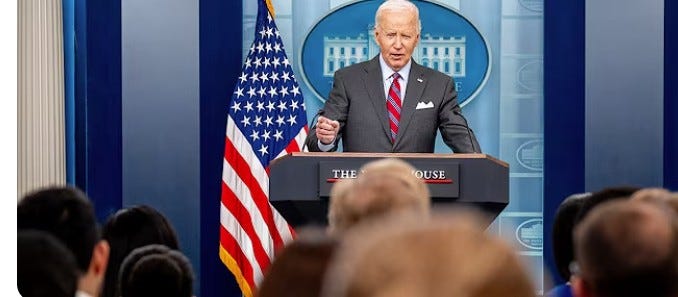Biden’s economy > Reagan’s economy
No one has won more electoral votes in the Electoral College than Ronald Reagan in 1984 with 525.
Even more impressive: if just 1,881 votes in Minnesota for Walter Mondale flipped, then Reagan would have become the only presidential candidate in history to have won all 50 states.
A rebounding economy, four years after “stagflation” derailed Jimmy Carter’s re-election, deserves much of the credit for Reagan’s landslide.
So it may interest you to know that by nearly every major economic metric, Joe Biden’s economy is better than Reagan’s economy.
More on that, but first, here’s the latest from the Washington Monthly:
***
***
In my Monthly article today, I compare Biden’s economy today to Reagan’s economy at the time of the 1984 general election: “the unemployment rate is lower, earnings are higher, the poverty rate is lower, inflation is lower, and interest rates are lower.“
Was Reagan’s 1984 economy better than it was four years prior? Absolutely (after a sharp recession on Reagan’s watch in 1981 and 1982). But it was hardly perfect.
To crush inflation, the Federal Reserve jacked up interest rates to sky-high levels, and the medicine had side effects.
The poverty rate was worse. Thirty-year mortgage rates remained around 14 percent (though down from 18.5 percent in October 1981). Similarly, the unemployment rate was down from a December 1982 peak, but by the general election it had only come down to where it was at Election Day 1980.
Yet Reagan’s ad team saw no need for a bifurcated we’ve-come-a-long-way-but-there’s-more-work-to-do message. Their “Morning in America” ad campaign was unadulterated optimism.
Why? As one of Reagan’s admakers said years later, “It was the beginning of the 24-7 news cycle. That started to have an impact on the American psyche. So, it was important to find the optimism that was still in most people, but they were starting to lose a grip on it.”
Today, a 24-7 news cycle sounds relaxed, as we doomscroll our social media feeds on a second-by-second basis. That’s why I believe the Biden campaign has to expend even more creative energy and advertising resources than the Reagan campaign to spread an optimistic narrative about the economy.
There is a plausible counter-argument: Our social media-driven discourse is too prone to negativity. The American psyche has lost its grip on optimism and it’s not coming back. An optimistic campaign message will be met with withering criticism.
We haven’t had many presidential campaigns in the social media era with an incumbent on the ballot. The first was 2012, and Barack Obama’s ad strategy was more tilted toward negative attacks against Mitt Romney than positive ads about his record.
But Obama did have a splashy, positive ad in October 2012 featuring Morgan Freeman titled “Challenges.”
Freeman intoned, “Every president inherits challenges, few have faced so many. Four years later our enemies have been brought to justice. Our heroes are coming home. Assembly lines are humming again—there are still challenges to meet, children to educate, a middle class to rebuild but the last thing we should do is turn back now.”
That was in the there’s-more-work-to-do mold, but still firmly praised Obama’s record.
Amidst a slew of negative ads in 2020, the Trump campaign tried to go positive, claiming Trump “built a great economy” and “the best is yet to come,” but that was a very hard sell during the pandemic-ravaged economy.
Today, the economy is stronger than in 2020, and in 2012, and in 1984. If there ever was a time a presidential campaign can help Americans rediscover their inner optimism, it’s now.
FIND THE MONTHLY ON SOCIAL
We’re on Twitter @monthly
We’re on Threads @WAMonthly
We’re on Instagram @WAMonthly
We’re on Facebook @WashingtonMonthly
Best,
Bill











